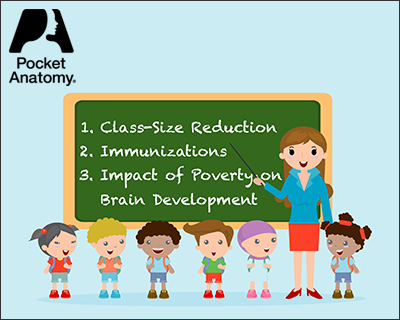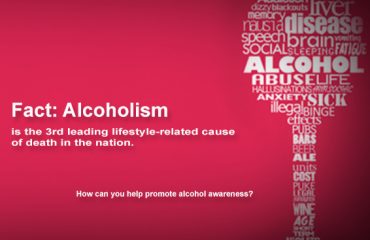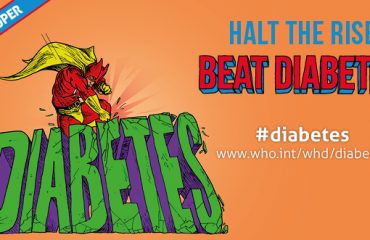In the spirit of starting a new school year, I’d like to focus on three varied topics in this blog post:
-
- (1) Class-size reduction
-
- (2) Immunizations for school entry, and
- (3) The impact of poverty on brain development.
You’ll see that these disparate topics actually have a common core: the health and welfare of our children as they grow and develop.
School may be the only place in a child’s life where the foundations of health are built. Having the opportunity to be in a place of learning where individual educational goals can be realized, being immunologically safe by being immunized, and being nutritionally secure by being fed the right nutrients are the foundational pieces that may be the best predictors of long-term health and happiness.
1. Class-size reduction
There has been much controversy in developed countries about the ideal class size for children in Grades 1 through 4. With teacher (and even bricks-and-mortar—shortages), most school districts are forced to “make do” with what they have. This often puts an undue stress on teachers, who face 25–30 children on a daily basis. Reaching the educational needs of each student is impossible, considering this amount of diversity in ability.
In an article in the American Journal of Public Health; a commentary published in the Journal of the American Medical Association; and a Eureka Alert from the American Association for the Advancement of Science (AAAS), Peter Muennig and Steve Woolf discuss the health and economic benefit of reducing class size in U.S. primary schools and the public health implications of government spending reductions, and point out that “budget decisions that affect basic living conditions — removing opportunities for education, employment, food security, and stable neighborhoods — could arguably have greater disease significance than disruptions in health care.”
When asked in a follow-up interview about the implications for education, based on information that kids who went to pre-school were found to have a higher economic status 25 years later, Dr. Woolf replied:
“We looked at what would happen if you reduced classroom sizes from kindergarten through third grade. Studies had already shown by that point, that doing that would actually improve outcomes for high school graduation and college attendance. We then factored in what the health implications would be of having a larger proportion of students attend college and achieve higher educational attainment, in terms of reduced medical spending and healthcare costs later in life.”
Reducing class sizes would increase graduation rates, producing 72,000 to 140,000 additional graduates each year. These additional graduates would in turn produce a net savings totalling $14 to $24 billion and 111,000 to 240,000 quality-adjusted life-years over their lifetimes.
Globally, it’s difficult to compare the class-size structure of one country to another, since the educational systems are often based on the culture of the country, where issues such as religion, respect for teachers, and economic status would play a part in the foundations of the educational system.
2. Immunizations for school entry
Since schools are the most prevalent place of assembly for children, it makes sense for those interested in the health of these children to put into play a regulation for them to be immunized against the common communicable diseases of childhood. Nationally in the U.S., every state has immunization requirements for primary and secondary school entry (and many states for college matriculation). These laws are based on the premise that the more children (and adults) who are immunized, the less chance there is for an outbreak of vaccine-preventable diseases. The concept of “herd immunity” is based on the immunization of the most people in any given community, thus limiting the chance of an outbreak if one or two individuals contract the disease; the disease will not spread to those who have immunity.
Disease outbreaks still happen: While some parents may question the need for immunizations since most of the vaccine-preventable diseases are rare in the U.S., there have been many cases of outbreaks in the past 10 years. During 2014 alone, the U.S. experienced a record number of measles cases, the most since 2000. Disease transmission occurs in both those children who have not been immunized and also in those older children (middle school-aged) whose immunity is waning. Thus, many states have now required re-immunization in that age group.
The U.S. Centers for Disease Control and Prevention (CDC) has online resources and tools for both parents and healthcare providers, to make sure that all children are adequately immunized in order to protect them against serious illness from these vaccine-preventable diseases. In addition, they provide a recommended immunization schedule for those aged 0 through 18 years.
Countries around the world have varying policies for the immunization of children for school entry. A Wikipedia entry on Vaccination Policy covers many of them. (Globally, a discussion of the use of immunizations to control outbreaks, serious disease, and death in Third-World Countries is beyond the scope of this blog post, but will be considered at a later time.)
3. Poverty and brain development
Based on an article in JAMA Pediatrics and highlighted in both a Scientific American article and a EurekAlert from the AAAS, growing up poor hinders brain development (atypical structure) and leads to poorer performance in school.

It has long been known that low socioeconomic status is linked to poorer performance in school, and recent research has linked poverty to smaller brain surface area. The current study bridges these converging lines of evidence by revealing that up to 20% of the achievement gap between high-and-low-income children may be explained by differences in brain development.
There are no easy answers or solutions to such deep divides in the socioeconomic inequity in developed countries. Several programs in the U.S., including Head Start, have made great strides in “levelling the playing field” for children born into poverty. The premise of Head Start is that “every child, regardless of circumstances at birth, has the ability to reach their full potential.”
Food and nutrition play a key role in a child’s physical development, including that of the brain. Basic nutritional foods are often absent for children born into poverty, through both a lack of food in general, and/or a lack of nutritious food choices. Large areas of urban U.S./inner cities have been the victim of large chain food stores moving to the suburbs, leaving corner stores and bodegas as the only option for families in poverty. Food choices are often deficient in both macro and micro-nutrients, high in preservatives, and high in sodium and sugar.
Improving access to healthy food is a critical part of providing low-income and inner-city children and youth with the nutrition they need to build and maintain healthy bodies and brains. Without the key ingredients to ensure brain health, the gap in educational success will continue to widen.
The intersection of these three topics is in the child who is about to enter school for the first time, a child who will (in a perfect world) be nutritionally and immunologically safe and secure, and assigned to a small classroom where all his/her educational needs will be met. But we’re not in a perfect world and there are many miles and milestones to go to reach equity and equality for these children.
Other resources:
AAUW sexual harassment and bullying in schools
CDC: Vaccine website for parents
WHO Global immunization data
WHO Fact Sheet
WHO Health Topics
————–
Are you teaching anatomy in your school? Discover how to get a 50% discount for your institution.




